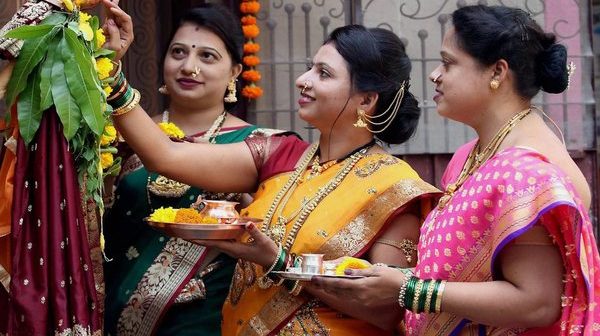As the winter chill fades and spring paints the landscape with vibrant hues, India awakens to the joyous celebration of Gudi Padva. Marking the beginning of the new year according to the lunisolar Hindu calendar, Gudi Padva, also known as Ugadi in South India, is a festival brimming with tradition, cultural significance, and delectable treats. This article delves into the essence of Gudi Padva, exploring its regional variations, traditional customs, and how you can be a part of this delightful spring celebration observed on April 9, 2024.
Gudi Padva: A Celebration Steeped in Tradition
The term “Gudi Padwa” originates from two words – “Gudi,” meaning a flag or emblem, and “Padwa,” signifying the first day of the lunar month. This auspicious occasion is observed by Maharashtrians, Konkanis, and parts of South India, with regional variations adding a unique flavor to the festivities.
Significance of Gudi Padva
Gudi Padva holds deep significance for Hindus. Here’s a glimpse into the different symbolic interpretations associated with the festival:
- Commemorating Creation: According to some beliefs, Gudi Padva marks the day Lord Brahma created the universe.
- Victory Celebrations: The festival is also seen as a commemoration of Lord Rama’s coronation in Ayodhya after his victory over Ravana.
- Harvest Festival: Coinciding with the spring harvest season, Gudi Padva signifies a time of renewed life, abundance, and prosperity.
- Shiva’s Cosmic Dance: In rural Maharashtra, the festival is linked to Lord Shiva’s cosmic dance and the coming together of the community.
The Enchanting Symbol: The Gudi Flag
A central element of the celebrations is the vibrant Gudi flag, a symbol of victory and auspiciousness. Traditionally made by families, the Gudi comprises a bright silk cloth adorned with mango leaves, neem leaves, and a sugar crystal garland (gaathi). A copper or silver pot is placed atop the cloth, symbolizing prosperity. This flag is hoisted high, often atop houses or rooftops, signifying the commencement of the new year.
Regional Variations: A Tapestry of Traditions
While the core essence of Gudi Padva remains the same, regional variations add a distinct character to the celebrations:
- Maharashtra: In Maharashtra, the festivities are most elaborate. Homes are adorned with colorful rangolis (floor art), families gather for elaborate pujas (prayers), and a special Gudi Padva procession might be held.
- South India: Celebrated as Ugadi in Karnataka, Andhra Pradesh, and Telangana, the festivities involve preparing a special dish called Ugadi Pachadi, a paste with a unique blend of sweet, sour, and salty flavors, reflecting the unpredictable nature of life.
- Goa: Known as ‘Saṁsāra Pāḍavo’ in Goa, the celebrations involve preparing a special sweet called ‘Shankarpale,’ exchanging gifts, and visiting temples.
Traditional Delights: Sweets that Sweeten the Celebrations
Gudi Padva is synonymous with delectable sweets, each region boasting its own culinary specialties:
- Maharashtra: Puran Poli, a flatbread stuffed with a sweet lentil filling, is a star attraction. Shrikhand, a creamy yogurt-based dessert, and Gulab Jamun, melt-in-your-mouth fried dough balls dipped in syrup, also grace the festive tables.
- South India: Ugadi Pachadi, as mentioned earlier, is a symbolic dish with a unique flavor profile. Bele Holige, a lentil-stuffed flatbread, and Obbattu, a sweet flatbread with various fillings, are also popular treats.
Observing Gudi Padva: A Guide to the Celebrations
Here’s a glimpse into how you can experience the joy of Gudi Padva:
- Prepare the Gudi Flag: If you’re feeling creative, get your hands on some fabric, mango leaves, and neem leaves to create your own Gudi flag.
- Whip Up Festive Treats: Explore recipes for Puran Poli, Ugadi Pachadi, or your favorite regional sweet to add a touch of tradition to your celebrations.
- Decorate Your Home: Create beautiful rangolis using colorful powders or rice.
- Offer Prayers: Perform a puja or simply light a diya (oil lamp) to usher in the new year with blessings.
- Connect with Loved Ones: Share a meal with family and friends, exchanging greetings and good wishes for the year ahead.
Gudi Padva: A Festival for Everyone
Gudi Padva transcends religious and cultural boundaries. Its message of new beginnings, prosperity, and celebrating life resonates with everyone. Here’s how you can embrace the spirit of the festival, even if you don’t hail from a region that traditionally celebrates it:
- Learn about the Traditions: Take some time to explore the customs and significance of Gudi Padva. This will give you a deeper appreciation for the festival.
- Embrace the Colors: Spring is a time for vibrancy. Decorate your home with colorful flowers, create a rangoli yourself, or even wear a bright outfit to embrace the festive spirit.
- Prepare a Sweet Treat: Explore recipes for Indian sweets like Puran Poli or Gulab Jamun. These delicious treats are sure to add a touch of sweetness to your day.
- Host a Spring Gathering: Organize a potluck with friends and family. Encourage everyone to bring a dish representing their culture or a spring-inspired recipe.
- Reflect and Renew: Use this occasion as a time for personal reflection. Set goals for the new year, express gratitude for the good things in your life, and look forward to new beginnings.
Gudi Padva is a vibrant festival that celebrates life, new beginnings, and the promise of spring. By participating in the traditions, indulging in delicious treats, and embracing the spirit of renewal, you can be a part of this joyous occasion, no matter where you are in the world. So, raise a glass (or a cup of chai!), savor the delectable sweets, and welcome the new year with a heart full of hope and optimism.





